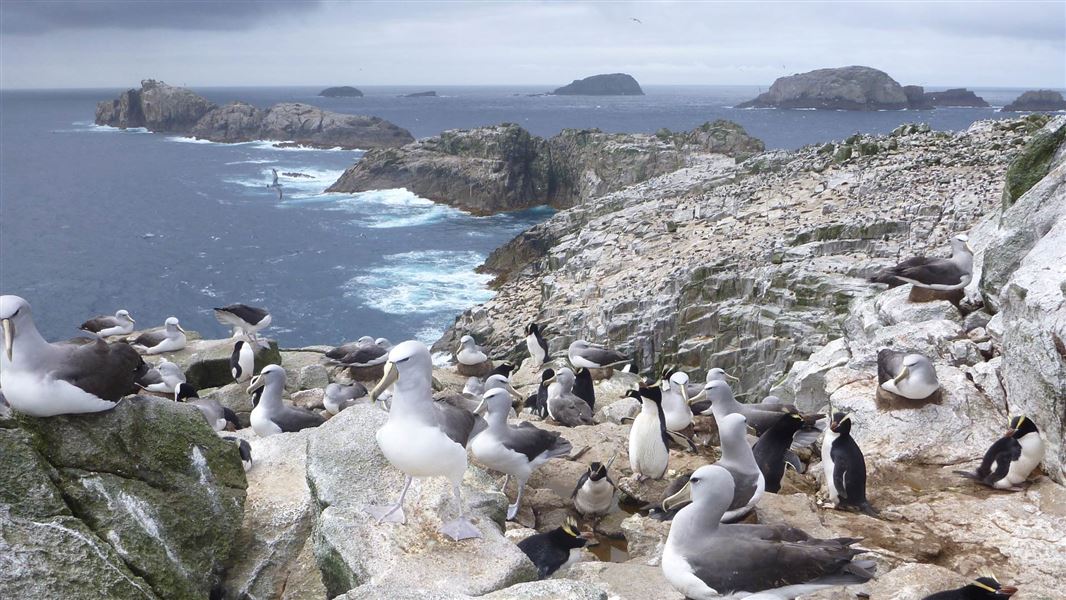Nature
At first view, these bleak subantarctic rocks appear anything but bountiful, but they are some of the most densely populated rocks in the Southern Ocean. They are also teeming with underwater life
The area is also teeming with underwater life. The water around the islands is extremely clear and visibility of 40 m has been recorded.
Surveys have shown that underwater species diversity and density is comparable to areas in the tropical and north pacific, like Galapagos island and Puget Sound.
The largest island of the Bounties is Depot Island (because there used to be a castaway depot on it) which is 800 m long and 88 m at its highest point. Bounty Islands/ Moutere Hauriri Marine Reserve covers 58% of their territorial sea. The islands themselves are all Nature Reserves.
Bounty Islands/Moutere Hauriri Marine Reserve was created in 2014, at the same time as marine reserves for the Campbell Island/Motu Ihupuku and Antipodes Island/Moutere Mahue islands.
There is a type 2 marine protected area covering the rest of the territorial sea. This prohibits bottom trawling, Danish seining and dredging.
History
They are a scattering of 20 igneous islets and rocks lying 700 km east-south-east of New Zealand. They were discovered by Captain William Bligh in 1788, just months before the mutiny on the Bounty, and the islands are named after this infamous ship. The name of the reserve translates as “angry wind”, a wonderful description of the conditions often found at these remote islands.
Species
The Bounty Islands can be smelt and heard from a sizeable distance, as every available rock that is not regularly swept by the sea is covered in New Zealand fur seals and seabirds, particularly during the summer breeding season.
The islands have the world’s largest breeding colony of New Zealand fur seals, with over 20,000 somehow squeezing on amongst the birds. There are around 30,000 breeding pairs each of Salvin’s mollymawks, erect-crested penguins, and fulmar prions, and around 500-600 pairs of the endemic Bounty Island shag.
Animals rearing their young don’t like to stray too far, so the marine reserve protects much of the marine environment used in the breeding season by birds and seals which range across the whole Southern Ocean, and beyond, during the rest of the year.
A generous layer of guano provides food and shelter for an endemic beetle and weta, and a couple of flightless moths. This guano has been enamelled by the sun to form a hard, shiny topping to the highest rocks. There is no soil on the Bounties, so these guano-dependent communities are a good example of the intimate and tenuous interdependence of land and sea creatures in the subantarctic ocean. Beneath the waterline, communities of sponges and shellfish depend on guano runoff.
Surveys have shown that underwater species diversity and density is comparable to areas in the tropical and north pacific (i.e. Galapagos island and Puget Sound). The water around the islands is extremely clear and visibility of 40 m has been recorded.
This underwater environment consists of many encrusting animals clinging to steep, stacked rock platforms in a highly energetic wave environment. Brightly-coloured sponges and large mussels and barnacles are a feature of the Bounty Islands. There is no shelter from the heavy seas except in cracks and crevices, where the more fragile animals shelter in tiny communities.
The giant spider crab and giant masking crab are conspicuous in the nearshore rocky reef community. Their leg spans can be around a metre, making them one of the largest predators in the nearshore environment.
There is no safe anchorage or landing place on the Bounty Islands. Boats can only safely navigate through the islands about one day in four, making research difficult. This, and the strict quarantine measures in place, is probably why there are no introduced predators on the Bounties.
Visiting the islands
You must have a permit to land – this is only given to visits with a high justification. You must strictly adhere to the minimum impact code.
